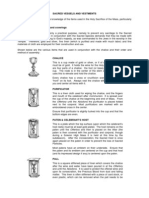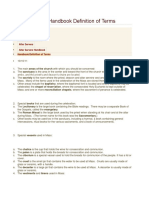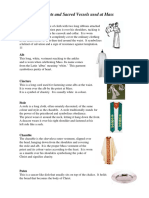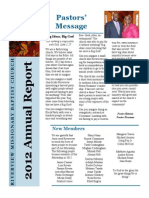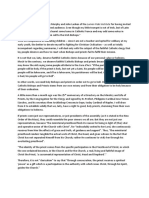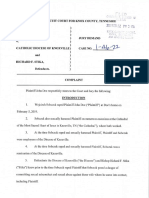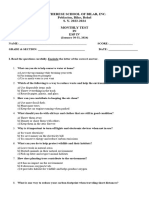Sacred Cups
Uploaded by
ScribdTranslationsSacred Cups
Uploaded by
ScribdTranslationsSACRED VESSELS
They are called 'sacred vessels' the various containers
used in the liturgical celebration... Some of them are
particularly important, such as the chalice and the paten 'in the
that are offered, consecrated, and take the bread and wine
289).
THE GOBLET: From the Latin word 'calix' (in Greek 'Posterion')
with which a sacred vessel is designated that is used in the
Eucharist to place the wine that will be consecrated (that
convert into the Blood of Christ). The chalice is blessed when it is
new or when it has been restored.
THE PATEN: A small, shallow dish or plate, slightly
concave, where the bread that will be consecrated is deposited in the
Body of Christ, in the Eucharist.
THE CHALICE: It is called a chalice or large cup, the sacred vessel.
what is used to conserve the Body of Christ in the
sacrarium.
CUSTODY: In the liturgy, this name is designated to a
sacred vase in which the Body of Christ is exposed for the
adoration of the faithful.
RELIQUARY: A consecrated container, intended to carry the
sacrament of the Eucharist or viaticum for the sick.
CRISMERAS: they are three sacred vessels made of metal or glass
what contains the oil of the sick, the oil of the
catechumens and the holy chrism. The holy oils are
blessed by the bishop, along with the priests at the Mass
chrism of Holy Thursday.
OTHER LITURGICAL OBJECTS
VINAJERAS: They are called vinajeras the two small jars that
used in the Mass for the water and the wine, which will be used
in the Eucharist.
BASIN AND JUG: These elements are used in the
Eucharistic celebration, for the washing of hands of
priest, before the Eucharistic prayer. This washing is a
rite of inner purification.
BELLFLOWERS: Bellflowers are small bells.
that began to be used within the celebration starting from
from the 13th century, to announce the moment of the consecration.
Nowadays, they are less necessary because the celebration
we can continue more easily, and its use has remained
limited to giving the celebration a festive and solemn enhancement.
CENSER: "Incense" in Latin is "tus,
thuris" or "tus, turis", from there comes the word "thurible". It is a
metallic brazier suspended by chains and with a
lid inside which incense is burned, either during the Mass,
in the Adoration of the Blessed Sacrament, in the processions or in prayer
of the hours.
It is called 'naveta' or 'navecilla' (a word that comes from
from the Latin "navicular"), to the small container that holds the
incense, and which has, precisely, the shape of a small ship.
ACETRE AND HYSSOP: The acetre is a small fountain that
it is used to hold holy water, and the hyssop is the
instrument used to spread water. These utensils
they should be used in blessings, in the Mass (in the rite of
sprinkling with water), Palm Sunday, etc.
SACRED ORNAMENTS
ALBA: It is a white tunic (from where the name comes),
broad, long-sleeved that covers the celebrant from above
down, which is called "talar" clothing. Generally
go under the Chasuble. The General Instruction of the Missal
Romano indicates that 'it is the common sacred garment for
all ministers of any rank” (No. 298).
It symbolizes the Purity and Innocence that the minister must observe.
in the Holy Sacrifice of the Mass.
AMITO: From the Latin 'amictus', from 'amicio, amicire', to surround,
to wrap. This is called the piece of white canvas, rectangular,
as a shoulder scarf, worn by the ministers of the
liturgy beneath the dawn. It is tied around the waist with some strips or
crossed ribbons.
RAIN CAP: Its name comes from the primitive use of
defend oneself from the rain. In the liturgy, it becomes clothing
of ceremony. It is used in processions with the Most Holy.
Sacramento.
CASULA: In Latin, casula means 'small house' or
“store”. It is the clothing proper to the priest to celebrate the
Mass. It must be worn over the alb and the stole.
It is of different colors: green, red, purple, white...
according to the time and the celebrations held in the Church,
it can also be gold, silver as a substitute for white.
It symbolizes Charity, Holiness, and the Priesthood, since
at the Altar, the Priest is no longer just a man, but
represents Christ.
CINGULO: The Latin word 'cingulum' comes from 'cingere',
to gird. It is a kind of rope whose function is to gird the dawn to
the waist. It symbolizes the Chastity of the Priest.
DALMATIC: In the ordination of deacons, a gesture
the complementary of the sacrament is the imposition of the
dalmatic. Deacons wear it over the alb and the stole
when they exercise their ministry, especially in the celebrations
more festive.
STOLE: the priest wears it around his neck and
pendant around the neck; the deacon wears it crossed.
To administer the Sacrament of Reconciliation or
Penance, the stole must be purple. For the
Eucharistic celebrations use the color of the Chasuble, and
making play with this. It is a sign of dignity and authority.
priestly, of the service entrusted by Christ to the Priest.
SOTANA: The word comes from the Latin subtana, or subtanea, from
subtus, which means underneath. A black garment that
covers the whole body. In the liturgical celebration, it tends to
carry white, which is the equivalent in white. It means to be
dead to the world, to earthly interests, to live
only for God.
COTA (or SOBREPELLIZ or ROQUETE): it is like a half alb.
it's a sign of purity and solemnity.
Liturgical Books
They are all those writings that contain the texts, gestures,
rites and norms for liturgical celebrations.
THE MISSAL: It is an official liturgical book that is used for the
Eucharistic celebrations. Currently, it contains.
the fundamental texts of the Eucharist: Rite of the Mass,
prayer of the time, of the Saints, particular, and prayers
Eucharistic. During the Eucharist, the missal can be placed
if not used in an appropriate place, either in the credenza or
in some other place. Except on the altar during the liturgy of the
word or at the end of the communion rite.
LECTIONARY: It is a series of 3 books that contains the
Biblical readings corresponding to each day to be
proclaimed in the assembly:
VOLUME I. From Advent to Pentecost.
VOLUME II. Ordinary time until the end of the liturgical year (they bring
first the 3 Sunday cycles, and then the 2 in between
week; then, the significant holidays of that period.
VOLUME III. Ritual Masses (of Sacraments), of the Common
of saints and for various needs.
Sundays comprise a large number of readings that
they are read every three years, forming the cycle A, B, and C each year.
During the week, there are two cycles of readings: I equal to years
odds, II equal to even years.
LITURGY OF THE HOURS: It gathers the psalms, antiphons,
readings, verses, responsories, canticles, hymns, and
prayers, praise for each day. Morning prayers and
evening
BLESSING: It puts into practice what was pointed out by the Council.
Vatican II, how the events of life sanctify and
they have religious significance for a person and the community.
That is why we give thanks to God and bless Him because He gives us
grants a house, a vehicle, a retail store...
LIENZOS
TABLECLOTH: It is called tablecloth in the liturgy, as in everyday use
family table, to the cloth that covers the altar, as a sign of respect
to the table at which Christ invites us to commune. It is usually
white, but it allows for decorations or stripes of another color. The tablecloth
It must be blessed, as it is the festive garment of the altar.
CORPORALS: The corporal is a white cloth.
square that is located starting from the offertory at the altar, to
place the chalice, the paten, and the ciborium during the Eucharist. The
name comes from the Body of the Lord. Its purpose is to prevent that
the particles of consecrated bread are lost or dispersed.
PALIA: It is square-shaped, which, according to the rubrics,
It must be made of cloth and blessed. It is used to cover the chalice,
preventing dust particles from settling on it.
It is a small colored cloth or towel.
white and rectangular shape with which the Priest dries himself
the hands in a sign of purification after having
bread and wine presented at the offering.
PURIFIER: From the Latin 'purum-facere' which means
purify. The white cloth that always goes is called a purifier.
folded into an elongated shape, it is placed over the low chalice under the
patena and is used to wipe the chalice after giving the
communion or also to wipe the lips and fingers of the
Priest. It also serves to clean the cross when it is
kissed.
CONOPEO: From the Greek 'konopeion', which is like a
veil or mosquito net. It is the veil that covered like a tent the
tabernacle where the Eucharist is reserved. It used to be used a
fabric of the liturgical colors specific to the time or feast.
Also, in smaller size, it was used for the chalice or
pixis, similarly in the manner of a cloak or tent. Now the
Conepeo is optional.
VEIL OR HUMERAL CLOTH: It is the veil that is placed over the
shoulders of the one carrying the Blessed Sacrament in a procession. The ritual
the Eucharistic cult prescribes it to give the blessing with the
Most Holy. It is also used when the Eucharist is carried in
procession, such as Holy Thursday for the reservation, or Friday
Saint to bring her back to the altar, or on the day of Corpus, or in the
dedication of a church.

































